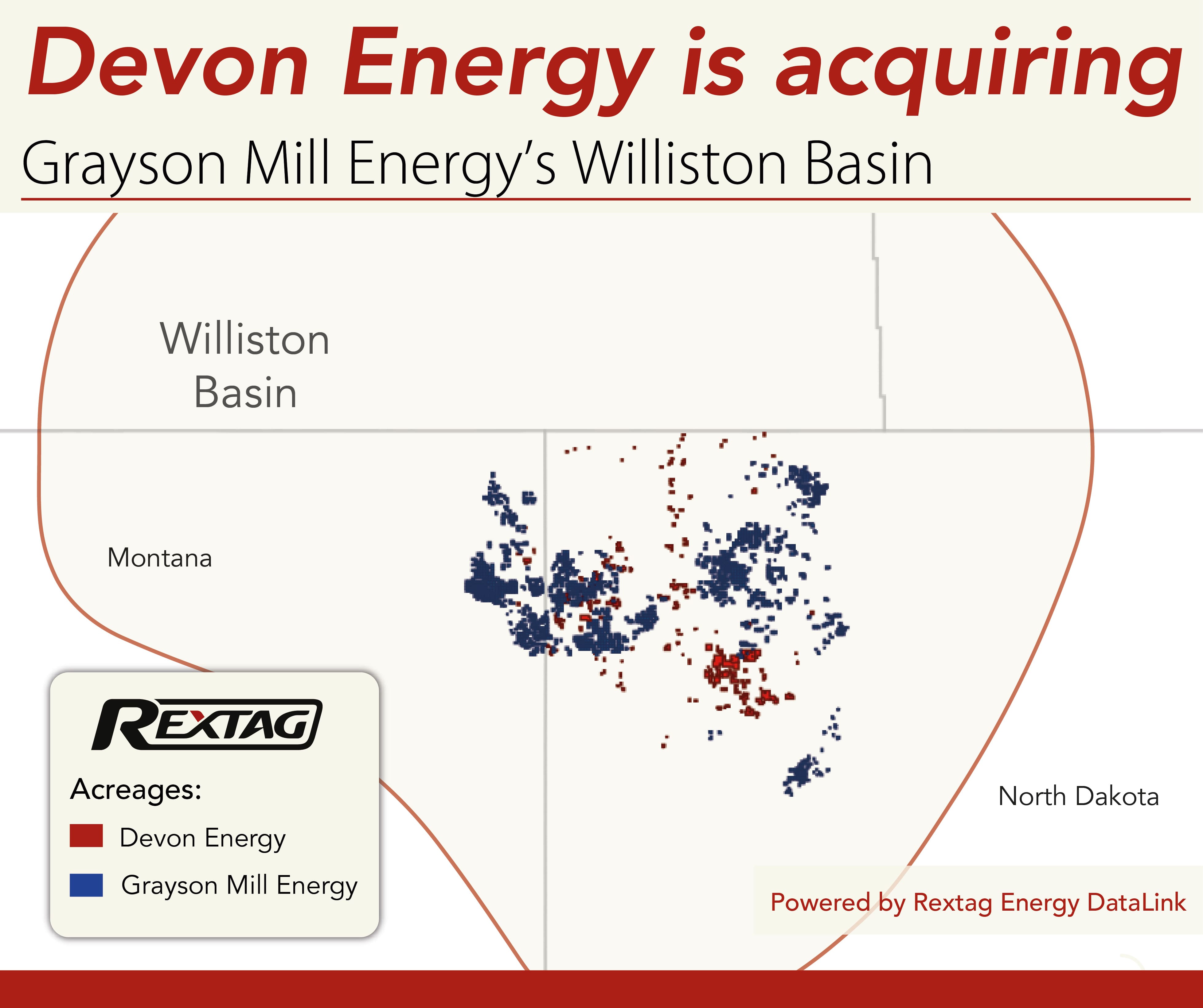Comprehensive Energy Data Intelligence
Information About Energy Companies, Their Assets, Market Deals, Industry Documents and More...
$5 Billion Grayson Mill Deal Expands Devon Energy's Williston Operations
07/09/2024
Based in Oklahoma City, Devon Energy is expanding its operations in the Williston Basin with a major $5 billion acquisition of Grayson Mill Energy, a company supported by the Houston-based EnCap Investments LP. This deal includes $3.25 billion in cash and $1.75 billion in Devon stock. Announced before the markets opened on July 8, this strategic move aims to boost Devon's oil production and operational scale significantly.
With this acquisition, Devon will add an impressive 307,000 net acres to its Williston Basin holdings, where it already has a 70% working interest. This expansion is expected to bring Grayson Mill's production to an estimated 100,000 barrels of oil equivalent per day (boe/d) by 2025, with oil making up 55% of this production.
This deal not only increases Devon’s oil production to an average of 375,000 barrels per day but boosts its total production to about 765,000 boe/d. Additionally, owning Grayson Mill's extensive midstream infrastructure, which includes 950 miles of gathering systems and various storage and disposal facilities, is projected to add over $125 million to Devon's annual EBITDAX. This infrastructure ownership also enhances Devon's market access and pricing capabilities.
In response to the acquisition, Devon's board has also increased the company’s share repurchase authorization by 67%, extending it to $5 billion through mid-2026, reinforcing the company's commitment to shareholder value.
This acquisition comes at a time when the U.S. upstream oil and gas sector is seeing significant merger and acquisition activity. Devon had previously explored expansion opportunities in the Permian Basin with Endeavor Energy Resources and CrownRock LP, though these companies were later acquired by other major players for substantial sums.
The Williston Basin itself has been a hotbed for energy deals, demonstrated by Chord Energy’s recent $4 billion acquisition of Enerplus Corp., which positioned it as a leading producer in the region. Additionally, TXO Partners LP has entered the Williston scene with two new acquisitions.
If you are looking for more information about energy companies, their assets, and energy deals, please, contact our sales office mapping@hartenergy.com, Tel. 619-349-4970 or SCHEDULE A DEMO to learn how Rextag can help you leverage energy data for your business.
Exploring the Energy Lifeline: A Tour of Williston Basin's Midstream Infrastructure
![$data['article']['post_image_alt']](https://images2.rextag.com/public/blog/R-149 - Blog Exploring the Energy Lifeline_ A Tour of Williston Basin's Pipeline Infrastructure.png)
The Williston Basin, which spans parts of North Dakota, Montana, Saskatchewan, and Manitoba, is a major oil-producing region in North America. In order to transport crude oil and natural gas from the wells to refineries and other destinations, a vast pipeline infrastructure has been built in the area. The pipeline infrastructure in the Williston Basin consists of a network of pipelines that connect production sites to processing facilities, storage tanks, and major pipeline hubs
U.S. Oil and Gas Drilling 2023-2024 Report: Rigs, Onshore, Offshore Activity, Biggest Companies
![$data['article']['post_image_alt']](https://images2.rextag.com/public/blog/R249_Blog_ U.S. Oil and Gas Drilling 2023-2024 Report_ Rigs, Onshore, Offshore Activity, Biggest Companies.png)
In January 2024, the United States saw a mix of ups and downs in the number of active drilling rigs across its major oil shale regions and states. Starting with the shale regions, the Permian Basin led with a slight increase, reaching 310 rigs, which is 3 more than in December. The Eagle Ford in East Texas held steady with 54 rigs, unchanged from the previous month. Meanwhile, both the Haynesville and Anadarko regions saw a decrease by 2 rigs each, landing at 42 rigs. The Niobrara faced a larger drop, losing 4 rigs to settle at 27. On a brighter note, the Williston Basin and the Appalachian region saw increases of 2 and 1 rigs, respectively, resulting in counts of 34 and 41 rigs.
![$data['article']['post_image_alt']](https://images2.rextag.com/public/blog/328_Blog_Why Are Oil Giants Backing Away from Green Energy Exxon Mobil, BP, Shell and more .jpg)
As world leaders gather at the COP29 climate summit, a surprising trend is emerging: some of the biggest oil companies are scaling back their renewable energy efforts. Why? The answer is simple—profits. Fossil fuels deliver higher returns than renewables, reshaping priorities across the energy industry.
![$data['article']['post_image_alt']](https://images2.rextag.com/public/blog/327_Blog_Oil Market Outlook A Year of Growth but Slower Than Before.jpg)
The global oil market is full of potential but also fraught with challenges. Demand and production are climbing to impressive levels, yet prices remain surprisingly low. What’s driving these mixed signals, and what role does the U.S. play?
![$data['article']['post_image_alt']](https://images2.rextag.com/public/blog/326_Blog_USA Estimated Annual Rail CO2 Emissions 2035.jpg)
Shell overturned a landmark court order demanding it cut emissions by nearly half. Is this a victory for Big Oil or just a delay in the climate accountability movement?